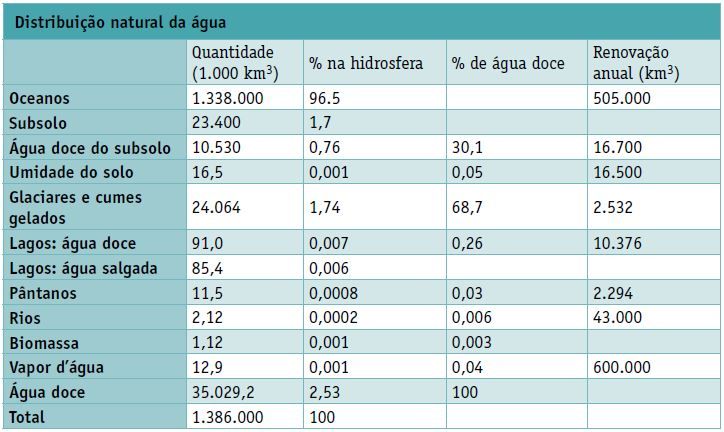Water in the world is characterized by the cyclic interaction of water in the liquid, solid and gaseous states (hydrological cycle). Evaporation, condensation, precipitation, infiltration and transpiration are the main elements of the water cycle.
At the global level, uneven water distribution is associated with different rainfall indices and geological factors. The intertropical zone is the most rainy, with emphasis on Central Africa, Brazil and Southeast Asia; the least rainy are North Africa and the Middle East. South Africa and Russia also have low rainfall rates. On the European continent, rainfall levels vary: in some countries, it rains around 500 mm / year and, in others, around 1500 mm / year.
Analyzing the table below, it is found that 97.5% of the planet's water is salty. Freshwater accounts for 2.5% of the Earth's total water and is concentrated in areas that make it difficult to take advantage of it (icy summits at high altitudes and the Antarctic continent).

At the global level, uneven water distribution is associated with different rainfall indices and geological factors. The intertropical zone is the most rainy, with emphasis on Central Africa, Brazil and Southeast Asia; the least rainy are North Africa and the Middle East. South Africa and Russia also have low rainfall rates. On the European continent, rainfall levels vary: in some countries, it rains around 500 mm / year and, in others, around 1500 mm / year.
Analyzing the table below, it is found that 97.5% of the planet's water is salty. Freshwater accounts for 2.5% of the Earth's total water and is concentrated in areas that make it difficult to take advantage of it (icy summits at high altitudes and the Antarctic continent).

It is important to note that in a number of countries in South America and Central Africa, despite the water supply, investments in infrastructure (basic sanitation) are lacking, making it difficult for a large portion of the low-income population to access water.
The lower availability of water occurs in the so-called Muslim world, with emphasis on the countries of North Africa and some countries in the Middle East.
In Japan and in European countries, high consumption in industry and agriculture reduces the availability of water to the population.
The lower availability of water occurs in the so-called Muslim world, with emphasis on the countries of North Africa and some countries in the Middle East.
In Japan and in European countries, high consumption in industry and agriculture reduces the availability of water to the population.



A qualidade da água para consumo humano é um indicador essencial para a avaliação do nível de desenvolvimento de um país e do bem-estar da sua população.
ReplyDeleteDe modo a garantir essa qualidade, as autoridades competentes procedem à recolha periódica de amostras de água para análise do cumprimento de diversos parâmetros químicos, físicos e microbiológicos. Tanto o número de análises como os valores referência dos diversos parâmetros são definidos pela legislação aplicável, o Decreto-Lei n.º 306/2007.
Esta ficha temática diz respeito a Portugal continental e será atualizada anualmente.
Objetivos e Metas:
A estratégia para o setor de abastecimento de água e saneamento de águas residuais, o Plano Estratégico de Abastecimento de Água e Saneamento de Águas Residuais 2020 (PENSAAR 2020), estabelece como meta para 2020 o valor de 99% de água segura.
Análise da evolução:
A qualidade da água para consumo humano tem vindo a registar, ano após ano, melhorias constantes e sustentadas, alcançando, em 2016, o valor de 98,69% de água segura na torneira do consumidor (indicador de água controlada e de boa qualidade), o que, num quadro regulatório cada vez mais exigente, representa uma efetiva melhoria da qualidade da água nos últimos anos.